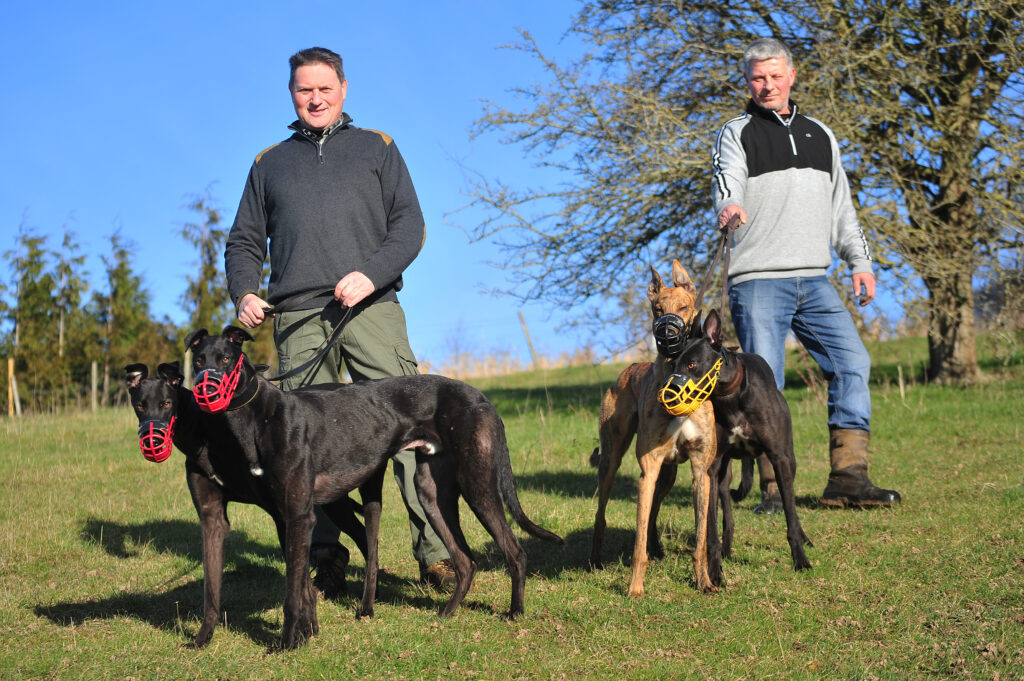Greyhound training is a comprehensive and systematic journey that commences when the dogs are around 15 to 17 months old. The exact start may be influenced by characteristics like the size of the dog, with larger dogs often starting a bit later to prevent excessive strain on their developing limbs. Training incorporates various physical exercises and behavioural norms that are key to competing effectively in greyhound races.
Initiation to Training
The initial stage of the greyhounds’ training period involves close observation by the dog’s keeper, particularly its response to chase situations. This provides insight into:
Physical characteristics: The size and weight of the greyhound could postpone training to prevent overstraining. Generally, greyhounds used in racing possess weights ranging from 28 kg to 36 kg (approximately 62 lb to 79 lb).
Mental inclination: The keeper’s observation allows them to assess the inherent chase instincts and potential avidity of each individual greyhound.
Training temperament: Dogs are taught essential skills like peaceful lead-walking, which is a crucial part of their training. Achieving this is particularly important in scenarios where a single person might need to walk multiple dogs simultaneously.
Fitness Regimen
Fitness development for racing greyhounds typically spans approximately six weeks. This regimen is facilitated by a series of walking, trotting, and sprinting drills.
Initial phase: Dogs begin by walking a mile every day for a ten-day period.
Intermediate phase: The daily distance is increased to two miles for the next ten days.
Advanced phase: Dogs are then transitioned to trotting for the equivalent distances. Trainers often ride bikes alongside the greyhounds during this phase.
Final phase: The dogs move on to full galloping when they can trot a mile without panting. This is often practiced on a track, involving a lure to entice the dogs into chasing.
The lure used during training is specifically designed to spark the dogs’ chasing instinct. It’s typically a sack tied to a moving cable, emphasizing that movement is the central point of attraction.
Legal Compliance
Legal regulations prohibit the use of live bait during greyhound training. Instead, trainers may use soft toys both as a training lure and as a reward. This is often the reason why many greyhounds develop an affection for soft toys.
Ownership and Registration
During the training phase, an owner is typically found for the dog. Interested individuals from various walks of life can become owners, including:
- Professional gamblers
- Farmers
- Businessmen
- Country folks
Some choose to own a dog as part of a syndicate. Like in horse racing, the greyhound often lives with the trainer and sees its owner sporadically. The animal is tattooed either in one ear (if in England) or both ears (if in Ireland) and is registered in the greyhound stud book.
Greyhound Racing and Tracks
The world of greyhound racing presents a multitude of choices when it comes to determining the best course of action for a newly trained racing dog. The most predominant decision involves selecting an appropriate racing track, with the options primarily split into two categories: registered and unregistered tracks.
Track Types and Regulations
Greyhound racing tracks can be categorized into:
Registered tracks: These tracks are officially registered with the Greyhound Board of Great Britain (known as the National Greyhound Racing Board until January 2009). They strictly adhere to the Greyhound Charter, ensuring consistent veterinary attendance, mandatory drug testing, and upholding the welfare of the dogs as a priority.
Unregistered tracks: Also referred to as ‘flapping tracks’, these establishments do not require compliance with the aforementioned standards. They do not mandate veterinary supervision or drug testing, and thus, attract criticism from animal welfare organizations.
Rules and Procedures at Registered Tracks
Registered tracks follow a complex and standardized procedure before a dog can participate in graded races.
Trials: Each racing greyhound must complete three trials. The first is conducted on an empty race track, followed by two alongside other dogs over the proposed racing distance.
Grader’s role: A Grader oversees these trials and plays a crucial role in determining the type of race a dog will participate in and from which trap it will start. The goal is to match each dog’s natural running style with an appropriate trap position to minimize collision chances.
| Dog’s inclination | Preferred Trap Position |
|---|---|
| Tends to run wide around the track’s outer side | Outer Trap |
| Prefers running close to the track’s inside | Inner Trap |
Greyhound Race Distances
Greyhound races occur over four varying distances:
- Sprint: Approximately 250 meters (270 yards)
- Middle distance: Roughly 450 meters (490 yards)
- Long distance: Close to 640 meters (700 yards)
- Marathon: Around 840 meters (920 yards)
The exact measurements are not consistent across all tracks due to differing physical specifications. However, one common factor is the presence of four bends in each track. For simplicity, races are often referred to by the number of bends, correlating with the race distance:
- Sprint: 2 bends
- Middle distance: 4 bends
- Long distance: 6 bends
- Marathon: 8 bends
Just like human athletes, some greyhounds excel in short distances, while others are more adept at longer ones. The job of the grader is to also decide the best race distance for each dog, to ensure their athletic potential is optimized.
Greyhound Racing Procedures and Standards
Greyhound racing is a sport guided by a detailed set of standards and procedures. The process involves weekly racing routines, distinct administration of tracks, and special attention to each participating greyhound’s welfare.
Weekly Racing Procedures
Greyhounds typically participate in racing events once a week. On race day:
Initial Checks: Upon arriving at the track, each greyhound undergoes a veterinary examination, followed by secure placement in a kennel, inaccessible to the public. This measure is taken to prevent any form of interference or tampering (‘nobbling’) with the dogs.
Race Sequence: The racing dog remains in the kennel until the designated race begins. The respective trainer then escorts the dog to the starting trap.
Safety Measures: During the race, the first bend point is the highest risk area for potential collisions or falls. Consequently, personnel are always stationed here to assist any injured animal.
| Race Segment | Potential Risk | Precautionary Measure |
|---|---|---|
| First bend of the race | Increased likelihood of collisions | Staff assigned for immediate help |
| Later bends in the race | Reduced risk due to less clustering | Minimal assigned staff |
As races conclude, a cover is quickly placed on the mechanical hare to prevent dogs from pouncing on it. Trainers then collect and praise their dogs, returning them to their secure kennels. If a steward’s enquiry or drug test is scheduled, the dog must remain in the kennel until the next race is run.
Determining Factors of Success in Greyhound Racing
Six primary elements influence success in a greyhound race:
- Grader’s role
- Dog’s condition (fitness and mental state)
- Trainer’s ability
- Track conditions
- Track management
- Competency of competing dogs and their trainers
Rules at Unregistered or Flapping Tracks
Unregistered, or flapping, tracks share similar race lengths as registered tracks. However, they lack grading systems, and there are no constraints against any dog participating in any race. Furthermore, these tracks do not guarantee a certain standard of welfare and veterinary support.
Life after Racing: Retirement and Adoption
Greyhounds are commonly retired from racing when they’re unlikely to reach top grades or when their performance starts to wane. The most accomplished dogs typically race until six years of age. Hence, retired greyhounds might be anywhere from under a year to seven years old.
Age of Retired Greyhounds: Most greyhounds are retired at around three to four years of age. Given the average lifespan of a greyhound extends into the early teens, these dogs have several healthy years ahead of them upon retirement.
Post-Racing Life and Greyhound Welfare
The fate of greyhounds after their racing careers varies significantly, with practices ranging from responsible rehoming to cruel abandonment. The well-being of retired greyhounds largely depends on the ethics and choices made by their trainers and owners.
Responsible Rehoming
Many trainers adhere to the Greyhound Charter and collaborate with rescue charities to rehome retired greyhounds. As part of this process:
Neutering: Responsible trainers arrange for the dog to be neutered before rehoming, or request that the racing owner contributes financially to cover rehoming expenses.
Charitable Organizations: Greyhound rescue organizations, such as Greyhound Rescue West of England (GRWE), work diligently to find suitable homes for retired racing dogs.
Unethical Practices and Disrepute
Unfortunately, not all trainers and owners prioritize the welfare of their retired greyhounds. Some unscrupulous individuals resort to cruel practices which tarnish the reputation of the sport. These methods include:
- Abandonment: Retired or unwanted dogs are sometimes left to fend for themselves, or given away indiscriminately without evaluating the suitability of their new caretakers.
- Inhumane Euthanization: While some conscientious individuals follow the Greyhound Charter’s advice on euthanization, others employ unlicensed individuals using unacceptable methods to put these dogs to sleep.
- Tampering with Identification: In extreme cases, certain trainers or owners may cut off the tattooed part of a greyhound’s ear before abandoning it, making it impossible to trace the animal back to its racing connections.
Thankfully, these cruel practices are becoming less common, indicating a gradual shift toward more humane treatment of retired greyhounds in the racing industry.
Frequently Asked Questions about Greyhound Training for Racing
Q: What is the ideal age to start training a greyhound for racing?
A: The optimal age to initiate greyhound training is when the dog reaches around 12 to 18 months. At this point, pups are physically and mentally equipped to actively engage in the demands of racing training.
Initiating the training process earlier than 12 months is discouraged, as the dog’s growth plates have not fully developed, posing the risk of injuries. Waiting until the dog is too old could result in insufficient time to properly develop crucial racing skills.
Q: What basic commands should a greyhound learn before racing training?
A: Before diving into racing-specific techniques, a greyhound should be taught fundamental obedience commands. The essential ones include Sit, Stay, Come, and walking on a leash without pulling.
Mastering these basic commands helps establish communication between the trainer and the dog, ensuring that the greyhound is responsive and capable of following directions during their racing career.
Q: How do you introduce a greyhound to the racing track?
A: Gradual exposure to the racing track is essential for a successful transition into a racing environment. In the early stages of training, trainers often visit the track for leisurely walks or brief play sessions. This helps acclimatize the dog to the new setting and surface.
As the greyhound becomes more comfortable with the track, the trainer can increase the intensity of training sessions, working up to full-speed sprinting and chasing exercises, which simulate the requirements of an actual race.
Q: How do you teach a greyhound to chase the lure?
A: One of the principal skills a greyhound must develop is the instinct to chase the lure. To nurture this behavior:
- Start with a basic object: Begin by introducing a basic object, like a stuffed animal, as the target. Entice the greyhound to chase after the moving object and praise them for their efforts.
- Transition to a mechanical lure: Once the dog consistently chases the basic object, it’s time to introduce them to a mechanical lure system. Begin at lower speeds to allow the greyhound to get accustomed before increasing the pace.
It’s important to make the training sessions enjoyable and rewarding, consistently providing positive reinforcement for their achievements.
Q: How often should a greyhound train for races?
A: Frequency of training depends on the individual dog’s fitness level, age, and experience. The consensus among trainers is that young, developing greyhounds should train 3-4 days per week, leaving adequate breaks for rest and recovery.
As the dog’s performance progresses, the training regimen should be adjusted accordingly. However, sufficient time for recuperation is crucial to avoid overtraining, injuries, and burnout.
Q: What is the importance of socialization in greyhound training?
A: Socialization is a vital aspect of greyhound training, as it prepares the dog for the diverse sights, sounds, and interactions that come with the racing environment. Gently introducing a young greyhound to various stimuli and situations minimizes the risk of issues like noise aversion, aggression, and anxiety.
Integrating socialization activities into a greyhound’s regular training routine enriches their overall experience, leading to a more confident and adaptable racing competitor.
Q: How do you maintain a greyhound’s physical fitness for racing?
A: To ensure optimal physical fitness, a greyhound’s training plan should incorporate regular cardiovascular exercise, muscular strength activities, and endurance training. Additionally, trainers need to monitor the dog’s weight, general health, and nutrition.
It’s also vital to be attentive to the dog’s behavior and adapt the training schedule accordingly. If any irregularities or potential concerns arise, reach out to a veterinarian for guidance.
Q: What should a greyhound’s diet consist of during training?
A: A greyhound’s diet during training should be well-balanced and tailored to their unique energy requirements. High-quality protein sources—like chicken, fish, and lamb—are crucial to sustaining and repairing muscles. Carbohydrates and fats provide essential energy for the dog’s performance.
It is advisable to consult a veterinarian or an experienced professional to create a customized nutrition plan suitable for the greyhound’s specific needs.
Q: How do you prepare a greyhound for their first race?
A: Preparing a greyhound for their inaugural race involves refining their racing skills, improving physical conditioning, and familiarizing them with pre- and post-race routines. Rehearsing handling procedures and equipment changes helps the dog feel comfortable and well-adjusted on race day.
Consulting with other experienced trainers or professionals for additional advice and guidance is also beneficial in ensuring a successful debut.
Q: What equipment is necessary for training a greyhound for racing?
A: When training greyhounds for racing, certain equipment is essential. Key items include:
- Leash: A sturdy leash is required for early stages of training and general obedience lessons.
- Muzzle: A well-fitting muzzle is also necessary, as it’s used during the races. Early familiarization helps dogs adjust to wearing a muzzle without discomfort.
- Racing Blanket: These jackets are color-coded for identification during races. Getting the greyhound gradually accustomed to wearing the blanket will ensure they are comfortable on race day.
- Training Lure: To cultivate the greyhound’s chasing instincts, use a moveable lure. Starting with a simple item before moving to an advanced mechanical lure is recommended.
Q: How can I tell if my greyhound is ready to compete?
A: Determining if a greyhound is ready to race involves several factors. A potential racing dog should:
- show a strong instinct to chase the lure
- be comfortable with the racetrack and racing equipment
- demonstrate endurance and speed
- remain relaxed in a racing environment
Additionally, a vet should assess the greyhound’s overall health and physical condition to certify that they are in racing shape.
Q: What do I do if my greyhound doesn’t show interest in racing?
A: Not all greyhounds will exhibit a keen interest in racing, and that’s okay. If your greyhound doesn’t seem drawn to chasing the lure or doesn’t enjoy racing training, there are other options. Greyhounds make excellent pets, and agility competitions or coursing events could be alternative activities for them.
Remember, every dog is unique and should be allowed to participate in activities they enjoy and where their natural instincts can shine.
Q: How do you keep a greyhound mentally stimulated during training?
A: Keeping a greyhound mentally stimulated is as important as physical training. Utilize training methods that are fun and engaging for the dog. Incorporating a variety of exercises, changing routines periodically, and allowing the dog time for free play will help keep them mentally stimulated.
Reward-based training, where the dog receives treats or praise for successful tasks, also promotes active engagement and mental stimulation.
Q: How do I ensure my greyhound remains safe during training?
A: Safety is paramount during greyhound training. Always keep the track surface in optimal condition to avoid injuries from an uneven or damaged track. Avoid strenuous training sessions during extreme weather conditions, and remember to provide enough water to prevent overheating and dehydration.
Be vigilant for signs of stress or discomfort during training. If your greyhound appears to be in pain, immediately halt training and consult with a veterinarian. Regular health check-ups will ensure that any potential issues are caught and addressed promptly.




